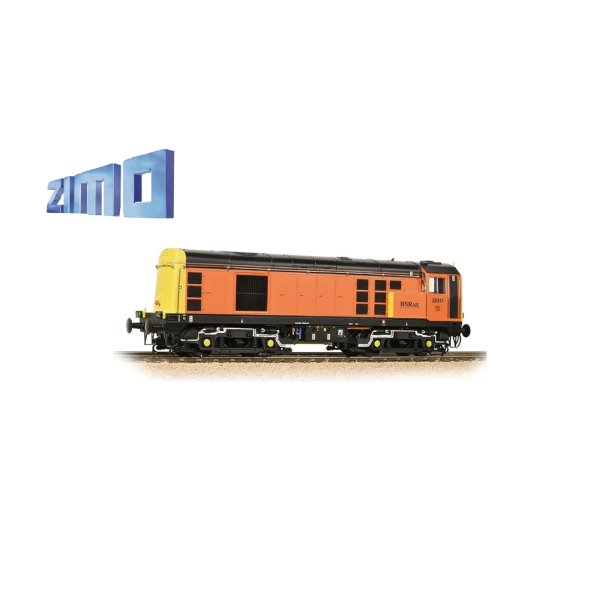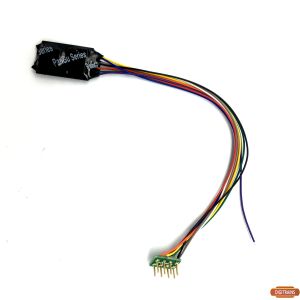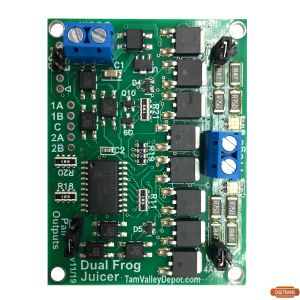Digitrains / Zimo Class 20 Sound Decoder
Click here to watch a video.
Class 20 DigiDrive E Version 3.0
Please spend a few moments to read these notes which have been produced so that you may obtain the maximum satisfaction from your new sound scheme.
The sounds should work perfectly when the decoder is fitted correctly. Individual locos may require some fine tuning that you can achieve with your DCC controller.
What is DigiDrive E?
This is a system developed to allow more prototypical sounds to be deployed across a wide range of operating conditions.
The sounds have been programmed in such a way that you, the user, may change the way that the sounds respond to your driving style or needs. This avoids the need for reprogramming and all the additional costs that would imply.
Please note
Some of the new controls will not operate correctly if you use 14 or 28 speed steps. Please ensure you use 127/128 speed steps to get maximum advantage of these important additions.
Throttle Response Scheme.
As supplied, the decoder will produce the sounds of Class 20 for use ‘on the mainline’. (CV265=101).
Use F1 to switch on the sound. After the start-up routine the loco will stand with the diesel engine, the Prime Mover (PM), ticking over at idle.
The sounds will respond to the throttle control in the following way:
Select speed step 1. The brakes will release, the PM will increase power to get the loco moving, and will continue until at higher speed, a further ramp up will be initiated until the final high speed running sounds begin. The precise speed steps will depend upon your model, so I suggest you make a note of the actual figures for your later use.
The sounds will spool down at similar points on deceleration.
Notice the transitions between the sounds which change in apparent power but with little change in speed. This is also prototypical, depending upon gradient and load.
In this, Version 3.0, there are extra control features to further enhance your driving pleasure.
Coast Mode
No matter what actual speed your model is travelling at, or which engine note range is playing, engaging F key 6 will put the sounds into ‘Coast Mode’ by spooling down the sounds to the appropriate level.
You still have full control of the speed, but the coasting sound will continue until you switch off F key 6; at which point the sounds will change to those relevant to the current speed. (Which includes standing).
Hint. Try using F key 6 to spool engine sounds down before throttling down to a halt – no more thrashing locos standing at signals or platforms. Remember to release F key 6 before setting off again!
Note for Version 3: This remains true and can be used in all cases from all speeds, but an alternative and automatic feature now spools the engine down to idle prior to stopping, provided the initial speed is not too high. See below.
Spool Down One
During any driving sound ‘loop’, at any speed, it is possible to cause the engine power to spool down to the level immediately below. This is easily achieved by reducing the speed by one step, or more. E.g., if the loco is playing power band 2 sounds, reducing speed with your throttle by one step will cause the sound to immediately spool down to the sound of power band 1, if in power band 1, it will spool down to idle.
This is a different control to F6 which always spools down immediately to idle/coast.
A further difference is that IF you have spooled down with this technique, acceleration of one speed step or more will immediately ramp the sound back up to the higher power. So you can now, at any road speed, vary the engine note by reducing or adding a single speed step.
Multi-Mode
Activated by F4, this enables multi-function changes with one key. Idle sound will be held for the first portion of driving, enabling yard movements etc without engine ramping. Whilst this is possible with F6 engaged before moving off, the difference here is that engine sounds will ramp up once a new threshold is reached. The switched features also include reduced inertia setting and automatic engine ramps to occur at higher speed steps.
F4 can be operated at any speed to give a fourth way in which the engine sounds at a given road speed may be modified instantly.
Applying More Power
Fed up with your loco dictating how you should drive? Now, you can call for more power from the engine at any intermediary speed. The duration of the increased power is configurable (default about 5 seconds)
Further enhancements mean that, at any speed step below maximum power sounds, large (10-20) speed step increments will cause the engine to ramp up and down automatically, whilst small increments will just ramp up according to the loco speed.
This feature works in conjunction with F6 and F4 to give a very high degree of control over the engine sounds without the need for ‘Manual Notching’.
CV Changes.
If you have a short end to end layout, or wish to trundle about ‘on shed’ CV#265 = 102 will change the way the decoder responds to your controller by changing many other CVs simultaneously. (CV265 = 103 is provided for operations in very confined spaces).
The main outcome is that the upward sound transitions begin at a lower speed and occur more quickly. (It’s possible to get a ‘00’ loco from standstill to full thrash and back down to idle before stopping - all within 6 feet of track!.
It’s now down to your skill and knowledge to simulate any eventuality!
|
F Key
|
Function/Sound
|
|
0
|
Lights
|
|
1
|
Sound On/Off
|
|
2
|
Horn
|
|
3
|
Two Tone Horn
|
|
4
|
Multi-Mode
|
|
5
|
Flange Squeal.(playable length, hold for long, release quickly for short)
|
|
6
|
Coast On/Off
|
|
7
|
Coupling
|
|
8
|
Aux 1
|
|
9
|
Fan
|
|
10
|
Spirax Valves
|
|
11
|
Air Brake release
|
|
12
|
Preparations
|
|
13
|
Compressor
|
|
14
|
Brake Squeal
|
|
15
|
Lo-Hi Horn
|
|
16
|
Priming
|
|
17
|
Door Slam
|
|
18
|
Air release
|
|
19
|
Fade all sounds
|
Driving Technique
At any time, and in any sound set, F6 will force the sounds to either hold idle or spool down to idle sounds. This affects only the sounds, actual speed is unaltered.
So, you can engage F6 before moving and the sounds will continue at idle even when the loco moves. Use this for light engine movements, where no extra power is required.
Or you can use F6 when already moving and the sounds will revert to idle for Coasting.
Releasing F6 in both cases allow the sound to go to the appropriate power level determined by the throttle position.
A new feature allows the power to drop to the next power level below if you decelerate by one speed step. Acceleration of one speed step allows the sound to return to the higher power. This works in any power band. Useful to switch between power levels at speed.
Try this:
These effects will operate in all sound sets, but the impact will be most pronounced in sound set three (CV265 = 103). The speed steps shown are just an example, it will operate similarly at all speed steps.
Engage F6 before driving off. Accelerate to speed step 10, release F6. The power will instantly begin to rise to full power.
Repeat the above, but before releasing F6, reduce the speed step to 9. Now the power will ramp up to the intermediary power only. Increase speed step to 10 and it will rise again to full power.
Or this:
Engage F6 before driving off. After a short distance, stop the loco.
Press F7.
Change direction.
Release F6 before driving off. Now the power will ramp up as your loco moves.. (Simulating a heavy train on the hook).
Congratulations, you now know how to roll, light engine, up to a train. Then couple up and drive away under power.
If you reduce speed gradually before stopping, the project will put the loco automatically into Coast mode at low speed, enabling a dignified halt without the engine sounds playing at full power. This is an automatic, low speed, alternative to manually controlled coasting using F6.
Remember. These new features will not operate correctly in 14 or 28 speed step modes. Using 126/127 speed step mode also allows imperceptible speed changes which nevertheless still trigger the sounds to change as described.





